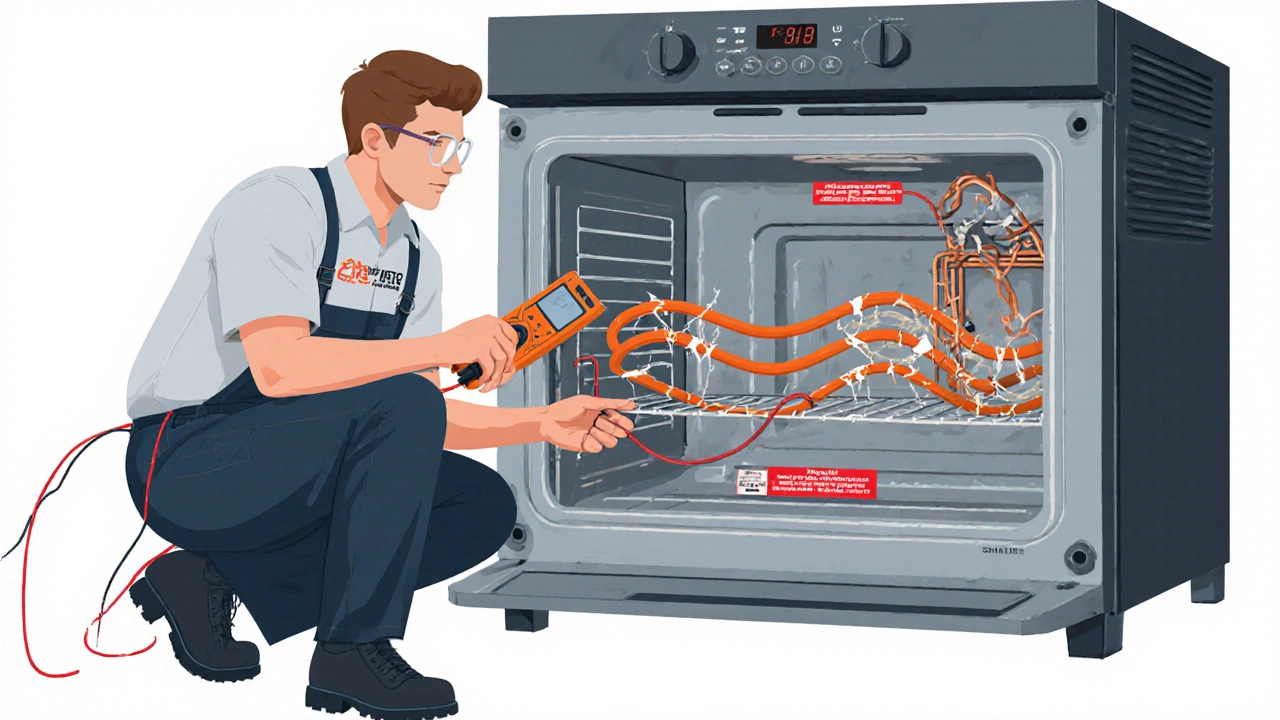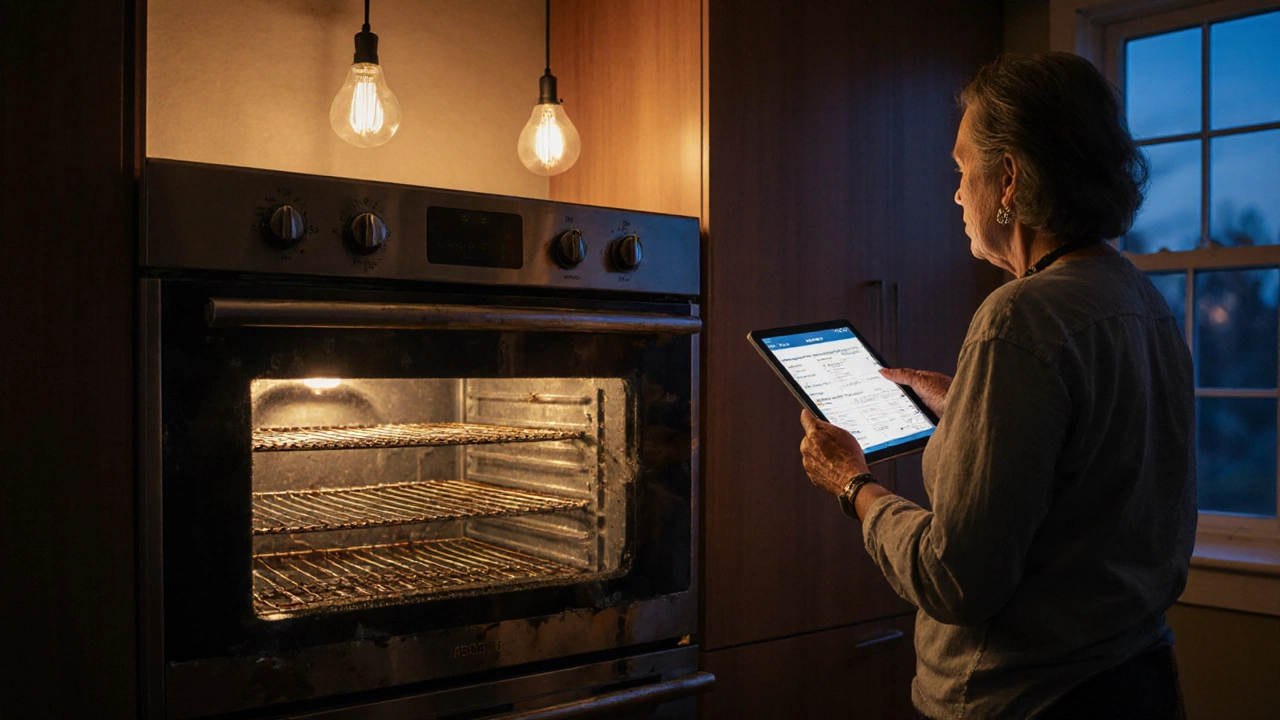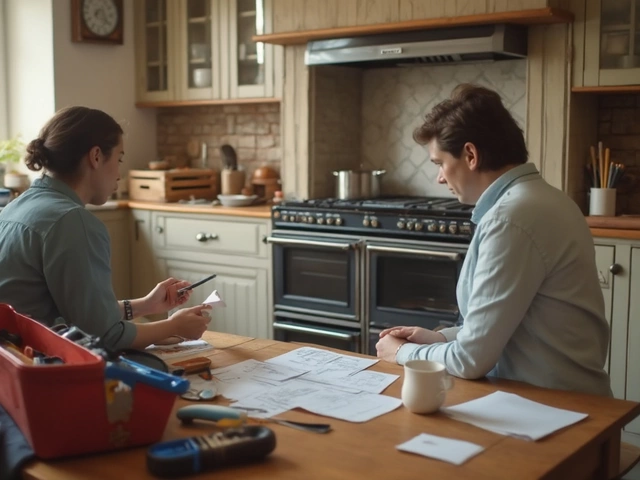Oven Repair vs. Replace Calculator
Enter values and click Calculate to see your recommendation
When your oven has been cooking meals for a decade and a half, it’s natural to wonder if a fix is worth the effort. Below you’ll find a practical roadmap to decide whether to repair a 15 year old oven, how much you might spend, and the hidden factors that tip the scale toward replacement.
Quick Takeaways
- Typical repair bills for a 15‑year‑old oven range from £80 to £250; a new mid‑range model starts around £400.
- If the oven’s total energy consumption exceeds modern efficiency standards by more than 30%, replacement often saves money within 3‑5 years.
- Safety issues (faulty wiring, gas leaks, or cracked doors) outweigh any cost‑saving argument - replace immediately.
- Consider environmental impact: repairing saves ~70% of the embodied carbon of a new unit, but only if the oven will last another 5‑7 years.
- Use the decision checklist at the end to make a confident call.
Understanding Your Oven’s Age and Expected Lifespan
In the UK, a well‑maintained electric or gas oven typically lasts 12‑15 years. Oven is a kitchen appliance designed for baking, roasting, and broiling food using heat generated by electric elements or gas burners that have been in service for 15 years is already at the upper end of that range.
Key lifespan indicators include:
- Frequency of breakdowns - two or more major faults in the past 12 months suggest wear is accelerating.
- Age of critical components - timers, thermostats, and igniters often have a design life of 8‑10 years.
- Energy efficiency rating - older models usually sit at A‑ or B‑rating, whereas new appliances frequently achieve A+++.
When these signs line up, the odds are higher that repair won’t extend the useful life beyond another 3‑5 years.
Common Faults in 15‑Year‑Old Ovens
Knowing what typically fails helps you gauge repair complexity and cost.
| Fault | What Happens | Average Labour + Parts |
|---|---|---|
| Faulty heating element | Oven fails to heat or heats unevenly | £120‑£180 |
| Bad thermostat / temperature sensor | Incorrect temperature readings, over‑ or under‑cooking | £90‑£130 |
| Igniter failure (gas ovens) | Ignite button does nothing, gas won’t light | £100‑£150 |
| Door seal degradation | Heat loss, longer cooking times, higher energy use | £70‑£110 |
| Electrical wiring wear | Intermittent power, safety hazard, tripping breaker | £150‑£250 |
These figures are based on recent surveys of independent repair shops across England and Wales. Prices vary by region and whether you have a warranty still in effect.

Cost Comparison: Repair vs. Replace
Putting numbers side‑by‑side clarifies the economics.
| Aspect | Repair | Replace |
|---|---|---|
| Up‑front cost | £80‑£250 | £400‑£1,200 (mid‑range to premium) |
| Energy usage | 30‑40% more than a modern A+++ oven | 10‑15% higher efficiency |
| Remaining functional life | ≈3‑5years (if no further faults) | ≈12‑15years |
| Environmental impact (CO₂e) | ~30% of new unit (manufacturing avoided) | 100% (new production) |
| Convenience | Potential downtime 1‑3days | Installation 1‑2days, plus removal of old unit |
Even though repairing looks cheaper initially, you must factor in higher running costs and the limited lifespan left. For many households, the break‑even point lands around 4‑5 years of use.
Safety and Regulatory Considerations
Older ovens may not meet current UK wiring regulations (Part P of the Building Regulations) or gas safety standards. A Gas safety check is a mandatory inspection in the UK to ensure gas appliances are correctly installed and do not pose a leak risk that costs £50‑£80, but skipping it can lead to dangerous leaks.
Red flags that demand immediate replacement:
- Visible scorch marks or cracked insulation on the heating element.
- Smell of gas when the oven is off.
- Repeated tripping of the circuit breaker.
- Loose or corroded wiring visible inside the oven cavity.
If any of these appear, treat the oven as a fire or explosion hazard - replace it rather than risk a repair that may not fully resolve the danger.
Environmental Impact: Repair vs. Replace
Manufacturing a new oven accounts for roughly 70% of its total lifetime carbon footprint. Repairing avoids that upfront burden, but only if the appliance runs efficiently for several more years.
When you replace, you can often recycle the old unit. Most UK retailers offer a take‑back scheme that ensures metal, glass, and electronic components are processed responsibly. However, the recycling process still emits CO₂, so the net environmental gain appears only after you’ve used the new oven for about 2‑3 years at a lower energy draw.
In short: if your repaired oven will stay under the 30% inefficiency threshold and last at least 5 years, the eco‑case for repair is solid. Otherwise, a modern, energy‑starred model wins.
Decision Checklist - Should You Repair?
- Diagnose the fault: Get a written estimate from a qualified technician.
- Compare cost: Is the repair bill less than 30% of a comparable new oven?
- Assess lifespan: Does the technician expect the oven to work reliably for at least another 3‑5 years?
- Check safety: Are there any gas or electrical hazards that could endanger the home?
- Energy impact: Will the repaired oven still consume 30%+ more electricity or gas than a new A+++ unit?
- Environmental angle: Does keeping the old oven significantly reduce waste and manufacturing emissions?
- Convenience factor: How long will the repair take and will you need a temporary cooking solution?
If the answer to any of the safety or lifespan questions is “no,” it’s time to replace.
Finding a Trustworthy Repair Service
Even if you decide to repair, you want a reliable tech. Here’s how to vet them:
- Verify they are Gas Safe registered for any work involving gas appliances in the UK (for gas ovens).
- Check for Electrical Installation Condition Report (EICR) certification that the electrician complies with UK wiring standards if the issue is electrical.
- Ask for references or read online reviews that mention punctuality and transparent pricing.
- Request a written quote that separates labour, parts, and any travel fees.
- Confirm they offer a warranty on the repair - at least 90 days is standard.
Local independent shops often charge less than big chains and can provide more personalized service, but always confirm they have the appropriate qualifications.
When Buying a New Oven Makes Sense
Even with a solid repair offer, a new oven can be the smarter move if you meet any of these conditions:
- Your kitchen remodel is already planned - matching design and dimensions saves hassle.
- Current energy bills are noticeably higher than average for your household size.
- You’ve experienced multiple breakdowns in the last two years.
- The oven lacks modern features you need (convection fan, smart controls, child lock).
- Your local council offers a grant for upgrading to energy‑efficient appliances.
In such cases, aim for an A+++ rated electric model or a high‑efficiency gas oven with a sealed combustion system.
Frequently Asked Questions
How long does a typical oven repair take?
Most common fixes - heating element, thermostat, or door seal - can be completed within a single service visit lasting 1‑2hours. Complex electrical rewiring may require a follow‑up appointment, extending the total time to 2‑3days.
Is it worth repairing a gas oven with a faulty igniter?
If the igniter costs under £80 and the oven is otherwise in good shape, repair is usually sensible. However, if the gas valve or wiring also shows wear, replacing the whole unit may be cheaper in the long run.
Can I get a discount on a new oven if I recycle the old one?
Many UK retailers run take‑back schemes that give you up to £50 off a new purchase when they responsibly recycle the old appliance. Check the retailer’s policy before buying.
What safety checks should I ask a repairer to perform?
Ask the technician to inspect the wiring for insulation damage, test the gas pressure (if applicable), verify the door seal integrity, and run a full temperature calibration. A written safety report is a good practice.
How does oven efficiency affect my energy bill?
An A+++ electric oven uses roughly 30% less electricity than a 15‑year‑old A‑rated model. If you bake 4‑5 times a week, the annual saving can be £80‑£120, shortening the pay‑back period for a new appliance.




